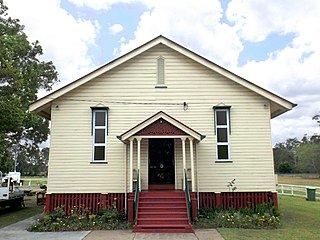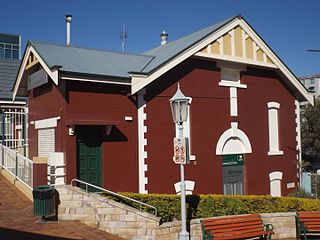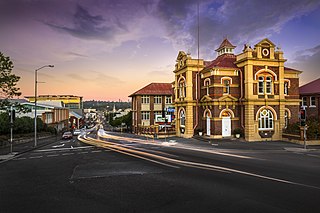
The Anzac Memorial is a heritage-listed war memorial, museum and monument located in Hyde Park South near Liverpool Street in the CBD of Sydney, Australia. The Art Deco monument was designed by C. Bruce Dellit, with the exterior adorned with monumental figural reliefs and sculptures by Rayner Hoff, and built from 1932 to 1934 by Kell & Rigby. This state-owned property was added to the New South Wales State Heritage Register on 23 April 2010.

St Luke's Church of England, Brisbane is a heritage-listed former church and now restaurant at 18 Charlotte Street, Brisbane City, City of Brisbane, Queensland, Australia. It was designed by John Smith Murdoch and built in by John Steward & Co. It is also known as Pancake Manor. It was added to the Queensland Heritage Register on 21 October 1992.

Old Ipswich Town Hall is a heritage-listed former town hall at 116 Brisbane Street, Ipswich, City of Ipswich, Queensland, Australia. It was designed by James Percy Owen Cowlishaw and built from 1861 to 1879. It is also known as Mechanics School of Arts and the School of Arts. It was added to the Queensland Heritage Register on 21 October 1992.

The Old Ipswich Courthouse is a heritage-listed former courthouse located at 73–75 East Street, Ipswich, City of Ipswich, Queensland, Australia. It was designed by Charles Tiffin and built from 1859. It was added to the Queensland Heritage Register on 21 October 1992.

Soldiers Memorial Hall is a heritage-listed memorial at 149 Herries Street, Toowoomba City, Queensland, Australia. It was designed by Hodgen & Hodgen (Toowoomba) and built from 1923 to 1959 by Smith Bros (Toowoomba). It was added to the Queensland Heritage Register on 17 December 1999.

Coorparoo School of Arts and RSL Memorial Hall is a heritage-listed school of arts at 208 Cavendish Road, Coorparoo, City of Brisbane, Queensland, Australia. It was built from 1892 to 1953. It is also known as Coorparoo School of Arts and Coorparoo Shire Hall. It was added to the Queensland Heritage Register on 6 January 1999.

Rosalie RSL Hall is a heritage-listed school of arts located at 50 Elizabeth Street, Paddington, City of Brisbane, Queensland, Australia. It was designed by Hall & Prentice and built from 1927 to 1928 by W Moody. It is also known as Rosalie School of Arts Commemoration Hall. It was added to the Queensland Heritage Register on 6 September 2005.

United Welsh Church is a heritage-listed union church at 6 Thomas Street, Blackstone, City of Ipswich, Queensland, Australia. It was designed by Samuel Shenton and built in 1886 by Worley & Whitehead. It is also known as Welsh Chapel and Welsh Union Church. It was added to the Queensland Heritage Register on 21 October 1992.

Fairy Knoll is a heritage-listed villa at 2A Robertson Road, Eastern Heights, City of Ipswich, Queensland, Australia. It was designed by George Brockwell Gill and built from c. 1897 to 1952 by Worley & Whitehead. It was also known as Jefferis Turner Centre. It was added to the Queensland Heritage Register on 21 October 1992.

Marburg Community Centre and First World War Memorial is a heritage-listed former bank and community centre at 71 Edmond Street, Marburg, City of Ipswich, Queensland, Australia. The bank building was designed by George Brockwell Gill and built in 1912 by Hastie and Halliwell. The war memorial was added in 1919. It is also known as National Bank of Australasia and Queensland National Bank. It was added to the Queensland Heritage Register on 21 October 1992.

Hotel Metropole is a heritage-listed hotel at 253 Brisbane Street, West Ipswich, City of Ipswich, Queensland, Australia. It was designed by George Brockwell Gill and built in 1906. It was added to the Queensland Heritage Register on 21 October 1992.

City View Hotel is a heritage-listed hotel at 277 Brisbane Street, Ipswich, City of Ipswich, Queensland, Australia. It was designed by George Brockwell Gill and built c. 1908. It was added to the Queensland Heritage Register on 21 October 1992.

St Paul's Anglican Church is a heritage-listed church at 124 Brisbane Street, Ipswich, City of Ipswich, Queensland, Australia. It was built from 1855 to 1929. It was added to the Queensland Heritage Register on 21 October 1992.

St Paul's Young Men's Club is a heritage-listed former clubhouse and now art gallery at 48 d'Arcy Doyle Place, Ipswich, City of Ipswich, Queensland, Australia. It was designed by George Brockwell Gill and built in 1911. It is also known as Ipswich Regional Art Gallery and St Paul's Young Men's Society Hall. It was added to the Queensland Heritage Register on 21 October 1992.

Ipswich Uniting Church is a heritage-listed Uniting church at Ellenborough Street, Ipswich, City of Ipswich, Queensland, Australia. It was designed and built by Samuel Shenton in 1858. It is also known as Ipswich Central Mission, Wesleyan Chapel, Ellenborough Street Methodist Church, and Ipswich City Uniting Church. It was added to the Queensland Heritage Register on 21 October 1992.

Queen Victoria Silver Jubilee Memorial Technical College is a heritage-listed technical college at 88 Limestone Street, Ipswich, City of Ipswich, Queensland, Australia. It was designed by architect George Brockwell Gill and built from 1897 to 1937. It is also known as Ipswich TAFE College and Ipswich Technical College. It was added to the Queensland Heritage Register on 21 October 1992.

Walter Burley Griffin Incinerator is a heritage-listed former incinerator at 10A Milford Street, Ipswich, City of Ipswich, Queensland, Australia. It was designed by Walter Burley Griffin and built from 1936 to 1940. It is also known as The Incinerator Theatre. It was added to the Queensland Heritage Register on 21 October 1992.

Uniting Church Central Memorial Hall is a heritage-listed church hall at 86 East Street, Ipswich, City of Ipswich, Queensland, Australia. It was designed by George Brockwell Gill and built from 1895 to 1895 by W Betts. It is also known as Congregational Sunday School. It was added to the Queensland Heritage Register on 9 July 1993.

Goomeri Hall of Memory is a heritage-listed war memorial hall at Boonara Street, Goomeri, Gympie Region, Queensland, Australia. It was designed by Philip Oliver Ellard Hawkes and built in 1926. It was added to the Queensland Heritage Register on 21 October 1992.

Gayndah Shire Hall is a heritage-listed town hall at 32–34 Capper Street, Gayndah, North Burnett Region, Queensland, Australia. It was designed by Hall & Phillips and built from 1934 to 1935. It is also known as Gayndah Soldiers' Memorial Hall, Gayndah Town Hall, and Gayndah and District Soldiers Memorial Hall and Council Chambers. It was added to the Queensland Heritage Register on 28 September 2001.
























